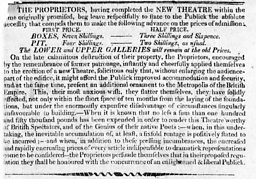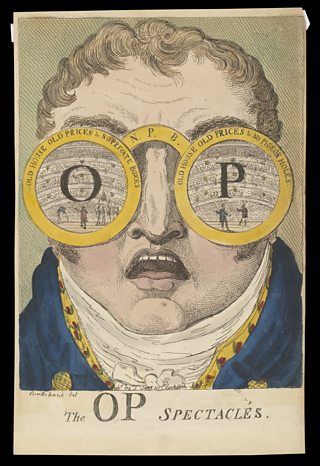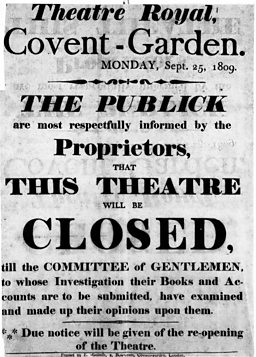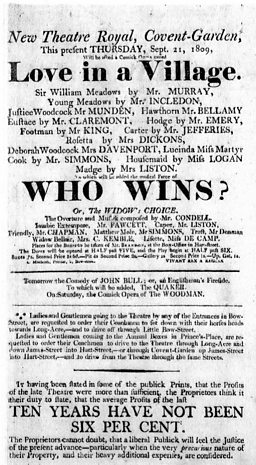The ticket price riots of 1809
The most famous riots in the history of theatre.
Georgian theatre was popular with everyone from all social classes. In 1809 Covent Garden was one of only two London theatres where they could go to see a play.
So when the theatre's management tried to increase the ticket prices following a costly rebuild it wasn't a popular move...
-
![]()
Much ado near me
Hear more Shakespeare stories on BBC Radio London
-
![]()
Shakespeare Festival 2016
The BBC celebrates the genius of the bard

Covent Garden theatre had just been rebuilt in a spectacular fashion after a disastrous fire
Unfortunately Drury Lane, the other licensed theatre, had recently burned down.
So for a while the newly rebuilt Convent Garden was the only theatre where the public of London could go to see plays.
Small wonder that seats for the grand opening were in high demand.
Macbeth was a popular choice, and it featured Mrs Siddons, the leading actress of the time, in her most acclaimed role, that of Lady Macbeth.
The management - keenly aware of the clamour to see the new theatre - were counting the cost of months of building work.
In the playbill they argue their case for the ticket increases – the cost of the new building is one hundred and fifty thousand pounds, the rent has increased sixfold, then there are costs for “Every article indispensable to dramatic representations” for the creation of a sumptuous theatre “an additional ornament to the Metropolis of the British Empire”.

What this hyperbole actually meant was higher ticket prices, a reduction in the size of the gallery – which was the cheapest place to sit – and an increase in the size of the private boxes which were taken by rich spectators.

Prices rose from six shillings to seven shillings for these boxes and three and six to four shillings for the pit and the third tier. Although prices for the gallery remained the same, it was so high and the rake so steep that the audience could only see the legs of the performers.
The “enlightened and liberal Public” referred to on this poster, were having none of it. When the theatre manager, John Kemble, stepped up on stage the applause quickly turned to hissing and yelling and the magistrates were called to read the riot act.
Similar disturbances continued on subsequent nights – the OPs (as the old price rioters called themselves) banged pots and pans together, carried banners, and sang songs – anything to disrupt the actors onstage.
Most of the riots took place in the pit or the floor of the theatre, which, with its best view of the stage, was where the most discriminating members of the audience sat on simple wooden benches.
The riots were about more than rising prices: at their heart was the principle that all social classes, regardless of wealth and status, should have the right to see classic drama such as Shakespeare.
On 14 December 1809, Kemble gave in, announced a return to the previous prices, and dropped all charges against the rioters.
The British government feared the rioters would pursue other, weightier causes like the price of bread or the war with France, but this did not happen.
The theatre was closed while a committee discussed the issue. When they supported the new prices rises, the riots started again.

The opening performance of the newly rebuilt theatre

About Shakespeare on Tour
From the moment they were written through to the present day, Shakespeare’s plays have continued to enthral and inspire audiences. They’ve been performed in venues big and small – including inns, private houses and emerging provincial theatres.

BBC English Regions is building a digital picture which tracks some of the many iconic moments across the country as we follow the ‘explosion’ in the performance of The Bard’s plays, from his own lifetime to recent times.
Drawing on fascinating new research from Records of Early English Drama (REED), plus the British Library's extensive collection of playbills, as well as expertise from De Montfort University and the Arts and Humanities Research Council, Shakespeare on Tour is a unique timeline of iconic moments of those performances, starting with his own troupe of actors, to highlights from more recent times. Listen out for stories on Shakespeare’s legacy on your BBC Local Radio station from Monday 21 March, 2016.
You never know - you might find evidence of Shakespeare’s footsteps close to home…
Craig Henderson, BBC English Regions

-
![]()
Shakespeare Lives
The nation’s greatest performing arts institutions mark 400 years since the Bard's death
Related Links
Shakespeare on Tour: Around London
-
![]()
Shakespeare's Players turned away in Kingston
The actors paid not to perform
-
![]()
The 1809 ticket price riots
The most famous riots in the history of theatre
-
![]()
The Lyceum Theatre performed Shakespeare in 1883
But which famous gothic writer worked here?
-
![]()
Charles Kean
The London theatre manager not lost for words
-
![]()
A historic performance of Coriolanus in London
The last performance of Coriolanus before the French Revolution
-
![]()
London's Female Romeo
Charlotte Cushman, who took Victorian London by storm
-
![]()
Curtains for London's Newington Theatre
The closure of London's first purpose built theatre south of the Thames
-
![]()
Blossoming at the Rose theatre
The history of the Rose playhouse
-
![]()
Shakespeare and the 'Night of Errors'
A series of unfortunate incidents at Gray's Hall
Shakespeare on Tour: Around the country
-
![]()
Ipswich: a magnet for Shakespeare?
Why did Shakespeare's company visit Ipswich ten times?
-
![]()
Sarah Siddons visits Norwich
Putting the Theatre Royal, Norwich, on the map
-
![]()
Madame Tussaud's exhibiton in Nottingham
Including a model of William Shakespeare
-
![]()
Touring Kent to avoid the plague
In 1592, the plague forced touring theatre companies out of London
















